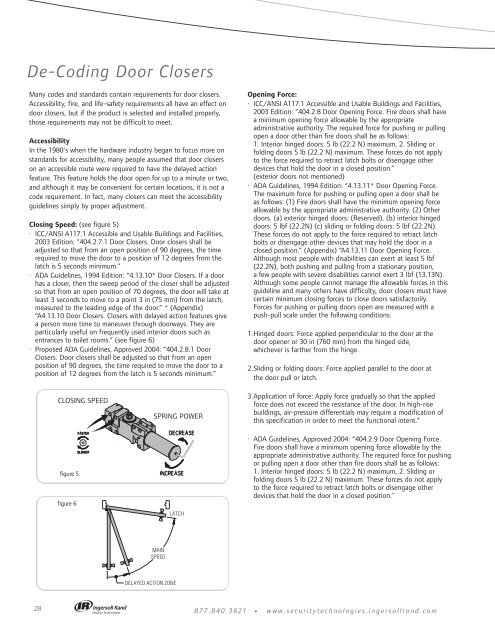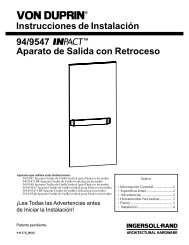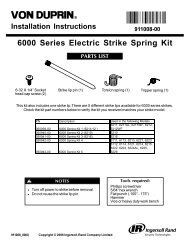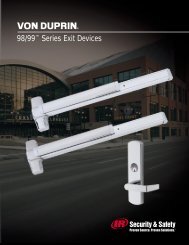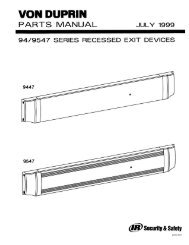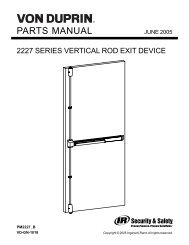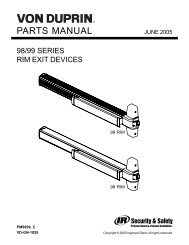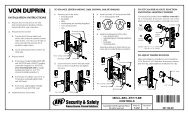Fire, Life Safety & Accessibility Codes - Von Duprin
Fire, Life Safety & Accessibility Codes - Von Duprin
Fire, Life Safety & Accessibility Codes - Von Duprin
Create successful ePaper yourself
Turn your PDF publications into a flip-book with our unique Google optimized e-Paper software.
De-Coding Door Closers<br />
Many codes and standards contain requirements for door closers.<br />
<strong>Accessibility</strong>, fire, and life-safety requirements all have an effect on<br />
door closers, but if the product is selected and installed properly,<br />
those requirements may not be difficult to meet.<br />
<strong>Accessibility</strong><br />
In the 1980's when the hardware industry began to focus more on<br />
standards for accessibility, many people assumed that door closers<br />
on an accessible route were required to have the delayed action<br />
feature. This feature holds the door open for up to a minute or two,<br />
and although it may be convenient for certain locations, it is not a<br />
code requirement. In fact, many closers can meet the accessibility<br />
guidelines simply by proper adjustment.<br />
Closing Speed: (see figure 5)<br />
· ICC/ANSI A117.1 Accessible and Usable Buildings and Facilities,<br />
2003 Edition: "404.2.7.1 Door Closers. Door closers shall be<br />
adjusted so that from an open position of 90 degrees, the time<br />
required to move the door to a position of 12 degrees from the<br />
latch is 5 seconds minimum."<br />
· ADA Guidelines, 1994 Edition: “4.13.10* Door Closers. If a door<br />
has a closer, then the sweep period of the closer shall be adjusted<br />
so that from an open position of 70 degrees, the door will take at<br />
least 3 seconds to move to a point 3 in (75 mm) from the latch,<br />
measured to the leading edge of the door.” * (Appendix)<br />
“A4.13.10 Door Closers. Closers with delayed action features give<br />
a person more time to maneuver through doorways. They are<br />
particularly useful on frequently used interior doors such as<br />
entrances to toilet rooms.” (see figure 6)<br />
· Proposed ADA Guidelines, Approved 2004: “404.2.8.1 Door<br />
Closers. Door closers shall be adjusted so that from an open<br />
position of 90 degrees, the time required to move the door to a<br />
position of 12 degrees from the latch is 5 seconds minimum.”<br />
CLOSING SPEED<br />
figure 5<br />
figure 6<br />
SPRING POWER<br />
Opening Force:<br />
· ICC/ANSI A117.1 Accessible and Usable Buildings and Facilities,<br />
2003 Edition: “404.2.8 Door Opening Force. <strong>Fire</strong> doors shall have<br />
a minimum opening force allowable by the appropriate<br />
administrative authority. The required force for pushing or pulling<br />
open a door other than fire doors shall be as follows:<br />
1. Interior hinged doors: 5 lb (22.2 N) maximum, 2. Sliding or<br />
folding doors 5 lb (22.2 N) maximum. These forces do not apply<br />
to the force required to retract latch bolts or disengage other<br />
devices that hold the door in a closed position.”<br />
(exterior doors not mentioned)<br />
· ADA Guidelines, 1994 Edition: “4.13.11* Door Opening Force.<br />
The maximum force for pushing or pulling open a door shall be<br />
as follows: (1) <strong>Fire</strong> doors shall have the minimum opening force<br />
allowable by the appropriate administrative authority. (2) Other<br />
doors. (a) exterior hinged doors: (Reserved). (b) interior hinged<br />
doors: 5 lbf (22.2N) (c) sliding or folding doors: 5 lbf (22.2N).<br />
These forces do not apply to the force required to retract latch<br />
bolts or disengage other devices that may hold the door in a<br />
closed position.” (Appendix) “A4.13.11 Door Opening Force.<br />
Although most people with disabilities can exert at least 5 lbf<br />
(22.2N), both pushing and pulling from a stationary position,<br />
a few people with severe disabilities cannot exert 3 lbf (13.13N).<br />
Although some people cannot manage the allowable forces in this<br />
guideline and many others have difficulty, door closers must have<br />
certain minimum closing forces to close doors satisfactorily.<br />
Forces for pushing or pulling doors open are measured with a<br />
push-pull scale under the following conditions:<br />
1.Hinged doors: Force applied perpendicular to the door at the<br />
door opener or 30 in (760 mm) from the hinged side,<br />
whichever is farther from the hinge.<br />
2.Sliding or folding doors: Force applied parallel to the door at<br />
the door pull or latch.<br />
3.Application of force: Apply force gradually so that the applied<br />
force does not exceed the resistance of the door. In high-rise<br />
buildings, air-pressure differentials may require a modification of<br />
this specification in order to meet the functional intent.”<br />
· ADA Guidelines, Approved 2004: “404.2.9 Door Opening Force.<br />
<strong>Fire</strong> doors shall have a minimum opening force allowable by the<br />
appropriate administrative authority. The required force for pushing<br />
or pulling open a door other than fire doors shall be as follows:<br />
1. Interior hinged doors: 5 lb (22.2 N) maximum, 2. Sliding or<br />
folding doors 5 lb (22.2 N) maximum. These forces do not apply<br />
to the force required to retract latch bolts or disengage other<br />
devices that hold the door in a closed position.˝<br />
28 877.840.3621 • www.securitytechnologies.ingersollrand.com


